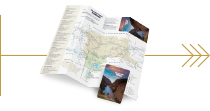Notes From the Road: Tracking Wolverines in Montana’s Yellowstone Country
It’s quite possible that my middle school was the least cool place to attend middle school in all the country. Not only were the green tile walls and the asbestos-laden classrooms detrimental to my health (though in fairness, they’ve likely been renovated), my coolest experience was getting to run a relay race around the school halls to raise money for cancer research (because we got to run in the halls, which is obviously the greatest joy for a pre-teen).Well, at Arrowhead Middle School, in Pray (Park County), they’ve got it a little more exciting than I did. In the beginning of January, sixth, seventh and eighth grade students set out with their teacher, Erin Lynch, and Greg Treinish, Founder and Executive Director of Adventurers and Scientists for Conservation (ASC), to learn how to track wolverines in Hyalite Canyon (did I mention that my science field trips included bus rides to the natural history museum?).
The project team initially met last January, when Lynch attended a teacher’s workshop about exploring Mount Everest at the Museum of the Rockies in Bozeman. Treinish was at the workshop, speaking on his month long wolverine tracking expedition in Mongolia.
After meeting at the Museum, Lynch invited Treinish to take her students on a day-hike, teaching them proper hiking etiquette, Leave No Trace ethics and natural skills, like building an emergency shelter and finding water.
The students enjoyed the hike so much that Lynch and Treinish began brainstorming ideas about how to make the outdoors a more relatable classroom.
"Many of our kids hunt with their families, so we thought teaching them how to track animals and how to identify their behaviors would be interesting and relevant to their worlds, while also being important units in school," said Lynch.
But more important, Lynch noted, was the practical application of data collection and analysis. While on the three-day, two-night excursion, students were responsible for keeping a field notebook, in which they recorded any animal tracks they found, the length, width and depth of the tracks, the distance between tracks, whether the animal walked, ran or bounded (like weasels are apt to do) and any other revealing characteristics, like tufts of hair or fur around tracks.
"One cool part was when we found a set of tracks, we got to follow it off trail, bushwhacking until we got to a body of water. The kids at first thought it was some sort of cat, but it turned out after to probably be a coyote."
Arrowhead provided most of the gear, but students were required to learn how to pack their own backpack and snowshoe the three miles into their campsite.
Lynch and Treinish also taught their students about winter camping. They showed them how to make snow platforms, anchor tents into deep snow and stay warm in chilly temperatures. The students learned to melt snow for water on camp stoves and were tasked with preparing and cooking all of their own meals.
Before they left on the third day, the students set up a trail camera at their campsite to collect video footage of any animals that happened to wander through. One of the students, along with a representative from ASC, will head back in a few weeks to collect the camera and review their results.
"When you go out into the woods with four middle school boys, it’s rarely quiet enough to see any real wildlife," Lynch said. Hopefully, the camera footage will make up for what they may have missed.


